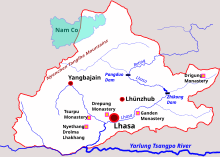Razheng River
| Reting Tsangpo | |
|---|---|

Landscape near the Reting Monastery
|
|

Lhasa prefecture-level city. Reting Tsangpo from the east joins other rivers at the Pangduo Dam to form the Lhasa River.
|
|
| Country | Tibet |
| Physical characteristics | |
| Main source | 5,500 m (18,000 ft) |
| River mouth | 4,080 m (13,390 ft) 30°11′30″N 91°20′40″E / 30.191622°N 91.344371°ECoordinates: 30°11′30″N 91°20′40″E / 30.191622°N 91.344371°E |
| Basin features | |
| River system | Brahmaputra River |
The Reting Tsangpo (Chinese: 热振河; pinyin: rè zhèn hé) is a river in the Tibet Autonomous Region of China. It is the main headwater of the Lhasa River. The river flows past Reting Monastery, founded in 1056. The terrain is geologically complex, with deeply eroded and faulted rocks that reflect the results of the collision of the Indian Plate with the Eurasian Plate.
The Reting Tsangpo originates in the Chenthangula Mountains at an elevation of about 5,500 metres (18,000 ft), and flows southwest. It has an average gradient of about 11 feet per mile (2.1 meters per kilometer). In one section the Reting Tsangpo runs through a 2,000 metres (6,600 ft) deep canyon. The river flows past the Reting Monastery. The monastery was founded in 1056 by Dromtön Gyelwai Jungne, a pupil of the Indian master Atiśa. The monastery is 21 kilometres (13 mi) from the mouth of the river.
The Lhasa River (or Kyi River) forms where the Reting Tsangpo is joined by two smaller rivers, the Phak Chu and the Phongdolha Chu which flows from Damxung County. The river is spanned by a large metal suspension bridge just above the juncture. The combined length of the Reting Tsangpo and the Lhasa River is about 400 kilometres (250 mi). The river is said to excellent for kayaking and white water rafting, although as of 2015 it had been visited by few tourists interested in these sports.
The Reting Tsangpo flows through the east central region of Tibet's Eocene block. The average elevation of the region is about 16,000 feet (4,900 m). The Tsangpo Suture is to the south and the northwest extension of the Ailao Shan Fault is to the north. Rocks in this region include sedimentary rocks from the Paleozoic and Mesozoic into which granite has intruded during the Cretaceous. The rocks have metamorphosed and are deeply eroded and faulted.
...
Wikipedia
